Project Critiques
-
Project Review: Kindred Britain
Kindred Britain http://kindred.stanford.edu/# Created by Nicholas Jenkins, Elijah Meeks, and Scott Murray. Maintained by Stanford University Libraries. Reviewed Jan. 2, 2019 – Jan. 4, 2019
The goal of this project is to show the relationships and connections between individuals. The argument is that the project can be used to uncover connections between people that aren’t well known. It also argues that history looks like a family tree. The method used is a family tree style setup which show different kinds of connections between people. The presumed audience seems to be academic scholars, as it has a lot of information on it that assumes background knowledge. It is also accessible to the general population though. Its basic format shows the connections between people in a way that’s easy to understand. The project is very interactive. The reader interacts with the content by dragging individuals to one another to view the connections between them. The interactions complement the argument because it allows the audience to view individuals their interested in, and let’s them follow paths that interest them. The project allows for more individual research and allows the audience to research topics that interest them. A print form wouldn’t have allowed for as much individual research or would have made it more difficult to find information. The digital component allows for people to follow their own interests easily, getting directly to information instead of going through a large amount to find specific details.
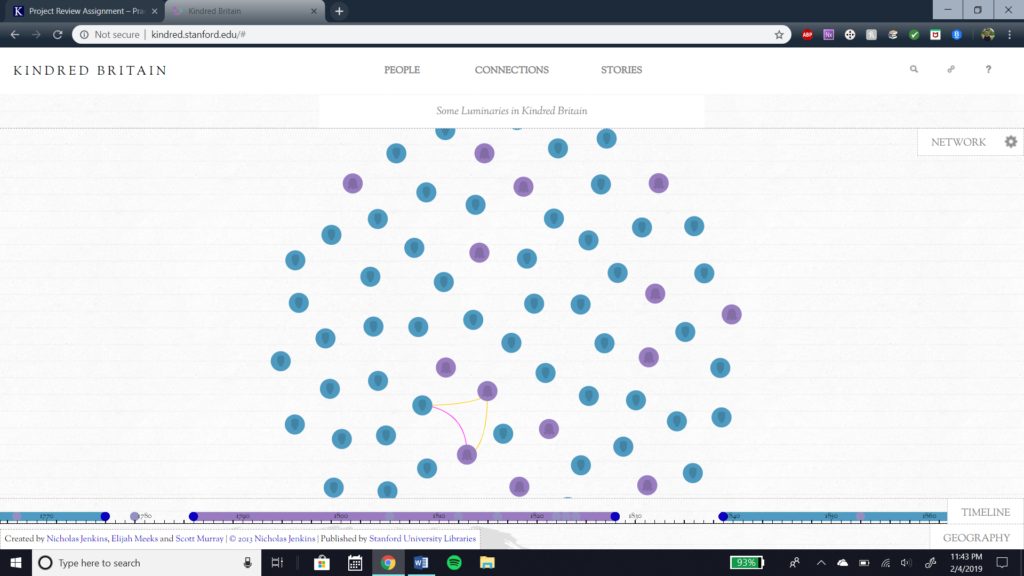
This is the main page of the project. 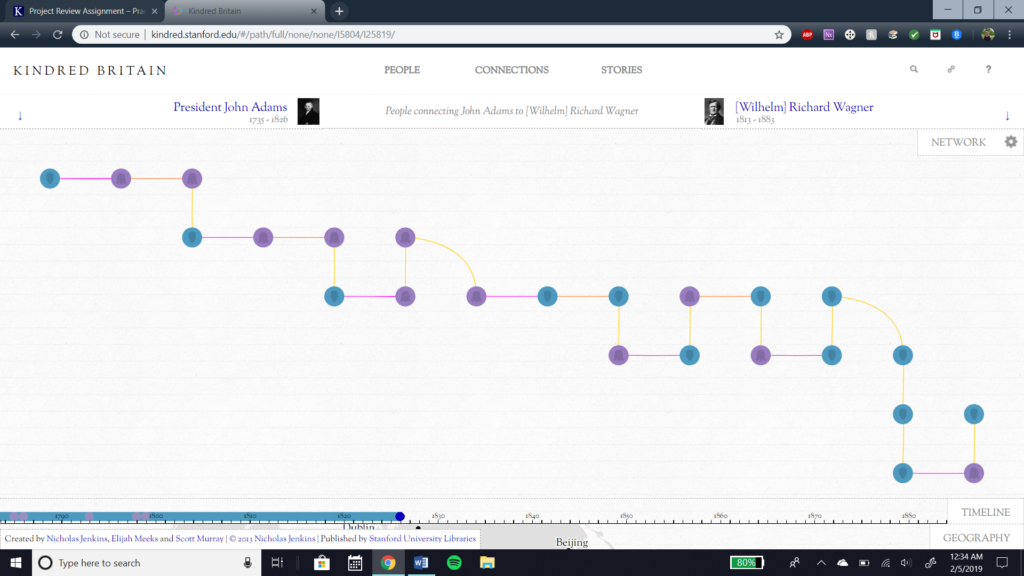
This is an example of the connections between individuals. -
Review: The Valley of the Shadow
The Valley of the Shadow: Two Communities in the American Civil War. http://valley.lib.virginia.edu/. Created and archived by Edward L. Ayers, the Virginia Center for Digital History, the Institute of Advanced Technology in the Humanities, and the University of Virginia Library. http://valley.lib.virginia.edu/VoS/usingvalley/background.html. Reviewed February 5, 2019.
The Valley of the Shadow is an online database consisting of thousands of letters, diaries, newspapers, and other records left by the residents of Augusta County, Virginia, and Franklin County, Pennsylvania. The project details the lives of hundreds of average citizens between John Brown’s raid on Harper’s Ferry and the end of Reconstruction.
-
Project Review: Negro Travelers’ Green Book, 1956
The Negro Travelers’ Green Book, 1956. https://digital.library.sc.edu/collections/the-negro-travelers-green-book-1956/. Created and maintained by the University of South Carolina Library, Columbia, South Carolina, https://sc.edu/about/offices_and_divisions/university_libraries/index.php. Reviewed February 4, 2019.
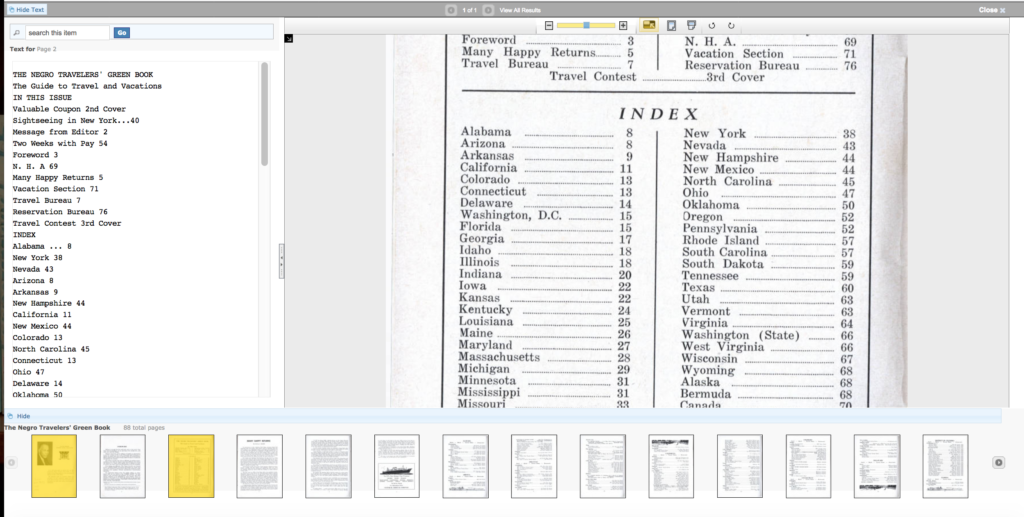
Pictured above is the index of the digitized Green Book -
Project Review: The Overland Trails
American Panorama: Overland Trails. https://dsl.richmond.edu/panorama/overlandtrails/. Created and maintained by the Digital Scholarship Lab, University of Richmond, https://dsl.richmond.edu/panorama/overlandtrails/#loc=5/-5.200/0.330&date=1/1/1840. Reviewed February 3,2019.
This project highlights both the differences and the similarities between the journeys of various travelers in their journeys on the Overland Trails. Many people chose to pursue a new life in the west between 1840 and 1860, and this project attempts to explain the context surrounding these migrations.
-
Review: Mapping Violence
“Mapping Violence.” https://mappingviolence.com. Created and maintained by the John Nicholas Brown Center for Public Humanities and Cultural Heritage, Brown University, Providence, RI (https://www.brown.edu/academics/public-humanities). Reviewed February 1 to February 4, 2019.
-
Last Seen: Finding Family After Slavery; a Review
Last Seen: Finding Family After Slavery. http://informationwanted.org/. Created and maintained by the Department of History at Villanova University in collaboration with Mother Bethel AME Church, http://informationwanted.org/about-us. Reviewed January 27, 2019-February 4, 2019.
Worked by a team of graduate students within Villanova’s history department, Last Seen: Finding Family After Slavery serves as a digital archive and teaching website that collects, transcribes and stores newspaper ads taken out by former slaves searching for their family members. The purpose of the website, as argued by the Last Seen team, is to provide new primary sources to genealogists and researchers, engage with the public, teachers and grade school students over the history of slavery, and give agency to former slaves that lived throughout colonial and United States history. Through the gathering of these newspaper sources and the methods employed by the Last Seen team in running the project, there are a series of different ways in which the have gone about achieving these goals.
-
Review: The People of Colonial Albany
“The People of Colonial Albany: A Community History Project.” https://exhibitions.nysm.nysed.gov/albany/. Created and maintained by the New York State Museum, Albany, New York, (https://exhibitions.nysm.nysed.gov/albany/whoarewe.html). Reviewed February 1 to February 4, 2019.
-
Review: Foreign-Born Population 1850-2010
Foreign-Born Population 1850-2010. https://dsl.richmond.edu/panorama/foreignborn/#decade=2010. Created and maintained by the Digital Scholarship Lab partnered with Stamen Design, https://dsl.richmond.edu/panorama/foreignborn/#decade=2010. Reviewed January 27, 2019-February 4, 2019.
Utilizing U.S. census records and county boundaries from 1850 to 2010, supplied by the Minnesota Population Center and the Newberry Library, the project Foreign-Born Population 1850-2010aims to show that a significant percentage of America’s residents were born outside the country’s borders. In doing so, the ultimate goal of the Foreign-Born Population project is to argue that because so many of the country’s residents have been born elsewhere, it is essential that researchers, historians and the American people look beyond the country’s borders to fully understand the history and culture of the United States.
-
Invasion of America. A Review.
by Joshua Porter
http://usg.maps.arcgis.com/apps/webappviewer/index.html?id=eb6ca76e008543a89349ff2517db47e6/. Project Director: Claudio Saunt, Russell Professor of History at the University of Georgia. Reviewed, Made for eHistory.org. Reviewed February 1-4, 2019.
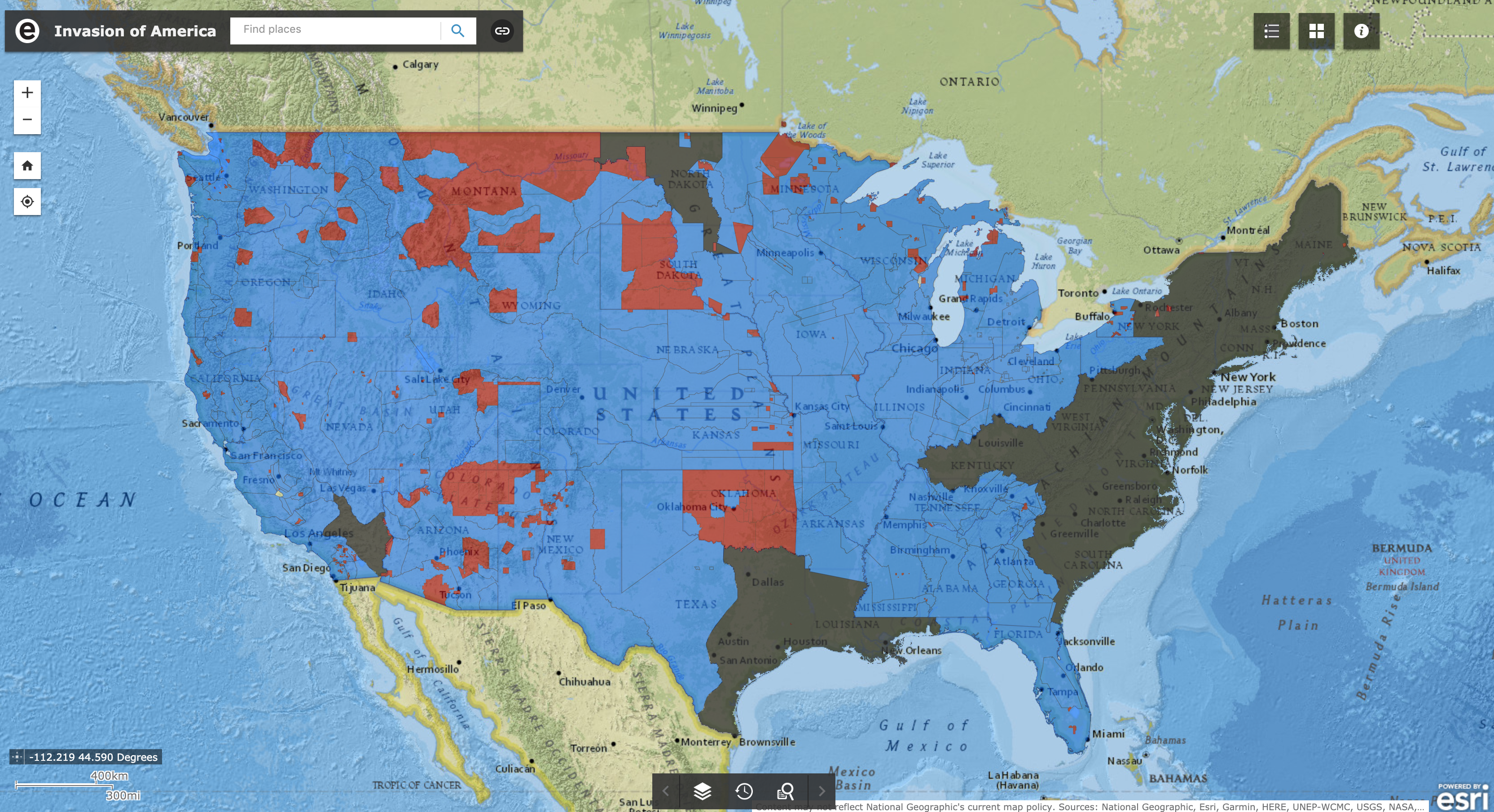
The Invasion of America The page loads and there, in blue, black, and red is the map of the United States. The words “Invasion of America” hang over the map casting a shadow against the country below. The invasion being shown is the cartographic representation of manifest destiny. The invasion by American settlers at the expense of Native Americans. The map shows how the plodding expanse of American boundaries chipped and chiseled away native lands until only blips of red remain in the ocean of blue. The project, headed by Russell Professor of History Claudio Saunt at the University Georgia, aimed to show how with each treaty and transaction the United States took over 1.5 billion acres at the expense of Native Americans.
-
Mapping the Republic of Letters Review
Mapping the Republic of Letters. http://republicofletters.stanford.edu/#. Stanford University? http://republicofletters.stanford.edu/contact.html. February 04, 2019.
Mapping the Republic of Letters is a huge dataset of primary sources and accompanying digital analysis. I cannot overemphasise the sheer size of this project. It is overseen by three persons, with a total of sixteen distinct contributors. Of those, three have contributed to more than one subproject, with the highest being three. There are 12 subsections, with each subsection of a case study containing as much information as the Pox Americana digital project. To call this a single project is a bit misleading as the various subprojects have certain levels of distinctiveness, betraying their creation by different scholars.
This project functions both as a digital narrative/database as well as a digitalized archive. The primary documents present are comprised of correspondence, travel logs, and notes. Not all three are available for every person studied however. These are paired with secondary digital analysis, spatial maps and neural networks, of the intersections between these collections and thinkers. Frequently, comparisons are made to other subprojects (ex: mapping Voltaire’s network as compares to Lockes).
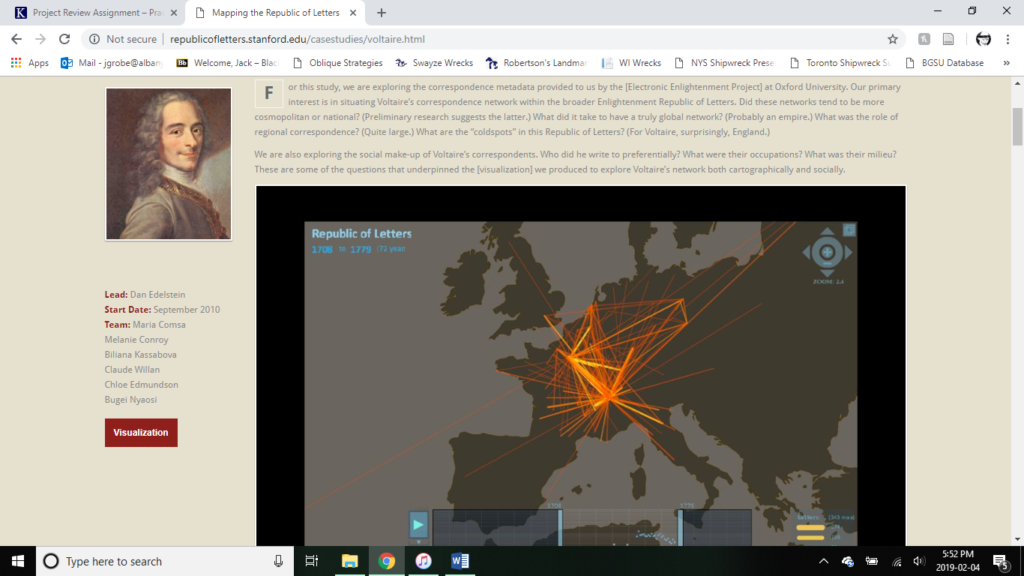
The overall project seems to be aimed at a scholarly audience. The amount of information contained is larger and more detailed than the average passing viewer is interested in as well as too bulky for a teaching aid in a classroom. The premise of the database is to reinforce the importance of social networks among intellectuals at the time as well as mapping out the intersections of thought and correspondence. There is also not a ton of interactive material, as pages exist mainly to subdivide the material into more easily consumable chunks. Some sections attempt to be interactive, but page errors like a failure to render a map or link dots with presentable info prevent this:

Navigation on the site is clear enough, with archival materials and analysis being presented in three categories being on the type of primary document being utilized: Correspondence, Publications, and Travel. The thinkers can not be grouped by nationality or subfield.
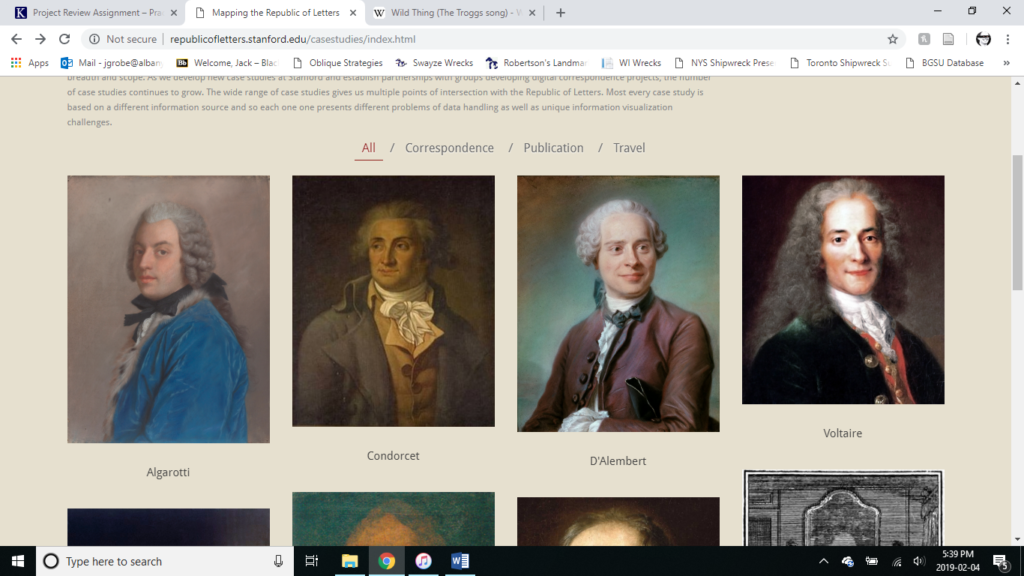
Despite the organization, it is very easy to get lost on the site given the huge amount of material. There are records available for intellectuals of England/the United Kingdom, France, Italy, and Spain. Records refer to other locations (like Italy) in the context of visitors to there from one of the three main empires studied. English thinkers are best represented along with the French. Spain is presented as a single entity without being broken down into individuals. Notably missing are Dutch, German, and Eastern European thinkers. The lack of the latter is understandable due to issues of preservation, but where are the Dutch like Antonie van Leeuwenhoek?
In the end, given the massive size and detail of this project and its subprojects, Mapping the Republic of Letters appears to offer itself most easily to scholars seeking to understand networks of thought and communication during the Age of Discovery. The amount of digital mapping of both spatial distance of correspondence as well as neural networks of correspondents is displayed most easily in a digital format. The maps could be printed off and consumed offline, but lack of interactiveness notwithstanding, this project is most easily consumable in a digital format.
This massive undertaking provides invaluable information and analysis for scholars studying the thinkers and intellectual networks of the Age of Discovery. With the addition of Dutch, Portuguese, and other passed over thinkers, this project will only become more valuable.